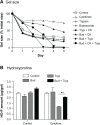Effect of budesonide on fibroblast-mediated collagen gel contraction and degradation
- PMID: 23576875
- PMCID: PMC3617814
- DOI: 10.2147/JIR.S35136
Effect of budesonide on fibroblast-mediated collagen gel contraction and degradation
Abstract
Background: The balance between production and degradation of extracellular matrix is crucial in maintaining normal tissue structure. This study was designed to investigate the effect of budesonide on fibroblast-mediated tissue repair and remodeling.
Methods: Using human fetal lung fibroblasts in a three-dimensional collagen gel culture system, we investigated the effect of budesonide (1-1000 nM) on collagen gel contraction and degradation in the presence or absence of Inflammatory cytokines (interleukin-1β and tumor necrosis factor α; 5 ng/mL each) and, in order to activate latent proteases, serine protease trypsin 0.25 μg/mL. The effects of budesonide on metalloproteinase production and activation were also investigated.
Results: Inflammatory cytokines significantly inhibited collagen gel contraction mediated by lung fibroblasts. Budesonide counteracted the effect of cytokines in a concentration-dependent manner (to 50%, P < 0.01). Budesonide 100 nM almost completely inhibited the release and mRNA expression of metalloproteinase-1, metalloproteinase-3, and metalloproteinase-9 induced by the cytokines (P< 0.05). Exposure to the cytokines plus trypsin increased collagen degradation and conversion of the metalloproteinases to lower molecular weight forms corresponding to their active forms. Budesonide blocked both enhanced collagen degradation (P< 0.01) and suppressed trypsin-mediated conversion of cytokine-induced metalloproteinase-9 and metalloproteinase-3 to lower molecular weight forms. Similar effects were observed with dexamethasone 1 μM, suggesting a class effect.
Conclusion: These findings demonstrate that budesonide directly modulates contraction of collagen gels and can decrease collagen degradation under Inflammatory conditions. The mechanism of this effect is through suppressing gene expression, release, and activation of metalloproteinases. By modulating the release and activity of metalloproteinases, inhaled budesonide may be able to modify airway tissue repair and remodeling.
Keywords: budesonide; metalloproteinase; tissue remodeling.
Figures







Similar articles
-
Thrombin and TNF-alpha/IL-1beta synergistically induce fibroblast-mediated collagen gel degradation.Am J Respir Cell Mol Biol. 2006 Dec;35(6):714-21. doi: 10.1165/rcmb.2005-0026OC. Epub 2006 Jul 20. Am J Respir Cell Mol Biol. 2006. PMID: 16858010 Free PMC article.
-
Anti-inflammatory effects of budesonide in human lung fibroblast are independent of histone deacetylase 2.J Inflamm Res. 2013 Aug 20;6:109-19. doi: 10.2147/JIR.S43736. eCollection 2013. J Inflamm Res. 2013. PMID: 24062615 Free PMC article.
-
Retinoic acid attenuates cytokine-driven fibroblast degradation of extracellular matrix in three-dimensional culture.Am J Respir Cell Mol Biol. 2001 Nov;25(5):620-7. doi: 10.1165/ajrcmb.25.5.4495. Am J Respir Cell Mol Biol. 2001. PMID: 11713105
-
Synergistic neutrophil elastase-cytokine interaction degrades collagen in three-dimensional culture.Am J Physiol Lung Cell Mol Physiol. 2001 Oct;281(4):L868-78. doi: 10.1152/ajplung.2001.281.4.L868. Am J Physiol Lung Cell Mol Physiol. 2001. PMID: 11557590
-
Red blood cells increase secretion of matrix metalloproteinases from human lung fibroblasts in vitro.Am J Physiol Lung Cell Mol Physiol. 2006 Feb;290(2):L326-33. doi: 10.1152/ajplung.00057.2005. Am J Physiol Lung Cell Mol Physiol. 2006. PMID: 16403942
Cited by
-
Effect of nebulized budesonide on respiratory mechanics and oxygenation in acute lung injury/acute respiratory distress syndrome: Randomized controlled study.Saudi J Anaesth. 2017 Jan-Mar;11(1):9-14. doi: 10.4103/1658-354X.197369. Saudi J Anaesth. 2017. PMID: 28217046 Free PMC article.
-
Nebulized Budesonide Prevents Airway Inflammation in Children with High Total IgE Levels After Open Heart Surgery with Cardiopulmonary Bypass: A Prospective Randomized Controlled Trial.Pediatr Cardiol. 2024 Sep 18. doi: 10.1007/s00246-024-03649-9. Online ahead of print. Pediatr Cardiol. 2024. PMID: 39292258
-
Alveolar macrophages drive lung fibroblast function in cocultures of IPF and normal patient samples.Am J Physiol Lung Cell Mol Physiol. 2023 Apr 1;324(4):L507-L520. doi: 10.1152/ajplung.00263.2022. Epub 2023 Feb 15. Am J Physiol Lung Cell Mol Physiol. 2023. PMID: 36791050 Free PMC article.
-
An in vitro 3D annulus fibrosus cell culture model with type I collagen: An examination of cell-matrix interactions.JOR Spine. 2022 Jan 31;5(1):e1193. doi: 10.1002/jsp2.1193. eCollection 2022 Mar. JOR Spine. 2022. PMID: 35386752 Free PMC article.
-
KGF-1 accelerates wound contraction through the TGF-β1/Smad signaling pathway in a double-paracrine manner.J Biol Chem. 2019 May 24;294(21):8361-8370. doi: 10.1074/jbc.RA118.006189. Epub 2019 Mar 20. J Biol Chem. 2019. PMID: 30894415 Free PMC article.
References
-
- Nagase H, Visse R, Murphy G. Structure and function of matrix metalloproteinases and TIMPs. Cardiovasc Res. 2006;69:562–573. - PubMed
-
- Han Z, Junxu, Zhong N. Expression of matrix metalloproteinases MMP-9 within the airways in asthma. Respir Med. 2003;97:563–567. - PubMed
-
- Suzuki R, Miyazaki Y, Takagi K, Torii K, Taniguchi H. Matrix metalloproteinases in the pathogenesis of asthma and COPD: implications for therapy. Treat Respir Med. 2004;3:17–27. - PubMed
LinkOut - more resources
Full Text Sources
Other Literature Sources

